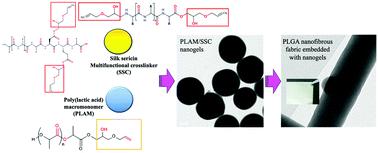当前位置:
X-MOL 学术
›
Polym. Chem.
›
论文详情
Our official English website, www.x-mol.net, welcomes your feedback! (Note: you will need to create a separate account there.)
Bio-derived and biocompatible poly(lactic acid)/silk sericin nanogels and their incorporation within poly(lactide-co-glycolide) electrospun nanofibers
Polymer Chemistry ( IF 4.6 ) Pub Date : 2022-05-24 , DOI: 10.1039/d2py00330a Arisa Kongprayoon 1 , Gareth Ross 1, 2 , Nanteetip Limpeanchob 3 , Sararat Mahasaranon 1, 2 , Winita Punyodom 4, 5 , Paul D. Topham 6 , Sukunya Ross 1, 2
Polymer Chemistry ( IF 4.6 ) Pub Date : 2022-05-24 , DOI: 10.1039/d2py00330a Arisa Kongprayoon 1 , Gareth Ross 1, 2 , Nanteetip Limpeanchob 3 , Sararat Mahasaranon 1, 2 , Winita Punyodom 4, 5 , Paul D. Topham 6 , Sukunya Ross 1, 2
Affiliation

|
Bio-derived and biocompatible nanogels based on poly(lactic acid) (PLA) and silk sericin (SS) have been synthesized for the first time. Low molecular weight PLA and SS were first modified using allyl glycidyl ether to create a PLA macromonomer and an SS multifunctional crosslinker (PLAM and SSC, respectively), as confirmed by NMR and FTIR spectroscopies. Nanogels were synthesized from PLAM/SSC and N′,N-methylene bisacrylamide (N′,N-mBAAm) as an additional bifunctional crosslinker via classical free-radical polymerization at systematically varied levels of additional crosslinking (0, 0.5, 1.0, 1.5 and 2.0 w/w% N′,N-mBAAm). Higher crosslink densities led to smaller nanogel particles with reduced accumulative drug release. Crosslinked PLAM/SSC nanogels at 0.5% N′,N-mBAAm with 400–500 nm diameter particles were shown to be non-toxic to the normal human skin fibroblast cell line (NHSF) and selected for incorporation within poly(lactide-co-glycolide) (PLGA) electrospun nanofibers. These embedded nanogel-PLGA nanofibers were non-toxic to the NHSF cell line and exhibited higher cell proliferation than pure PLGA nanofibers, due to their higher hydrophilicity induced by the PLAM/SSC nanogels. This work shows that our new crosslinked-PLAM/SSC nanogels have potential for use not only in the field of drug delivery but also for tissue regeneration by embedding them within nanofibers to create hybrid scaffolds.
中文翻译:

生物衍生和生物相容性聚(乳酸)/丝胶纳米凝胶及其在聚(丙交酯-乙交酯)电纺纳米纤维中的掺入
首次合成了基于聚乳酸 (PLA) 和丝胶蛋白 (SS) 的生物衍生和生物相容性纳米凝胶。NMR 和 FTIR 光谱证实,首先使用烯丙基缩水甘油醚对低分子量 PLA 和 SS 进行改性,形成 PLA 大分子单体和 SS 多功能交联剂(分别为 PLAM 和 SSC)。纳米凝胶由 PLAM/SSC 和N ', N-亚甲基双丙烯酰胺 ( N ', N -mBAAm) 作为额外的双功能交联剂通过经典的自由基聚合在系统变化的额外交联水平 (0, 0.5, 1.0, 1.5 和2.0 w/w% N ', N-mBAAm)。较高的交联密度导致较小的纳米凝胶颗粒具有减少的累积药物释放。交联的 PLAM/SSC 纳米凝胶在 0.5% N ', N -mBAAm 与 400-500 nm 直径的颗粒被证明对正常人皮肤成纤维细胞系 (NHSF) 无毒,并被选择掺入聚 (丙交酯-co) 中。-乙交酯)(PLGA)电纺纳米纤维。这些嵌入的纳米凝胶-PLGA 纳米纤维对 NHSF 细胞系无毒,并且比纯 PLGA 纳米纤维表现出更高的细胞增殖,这是由于它们由 PLAM/SSC 纳米凝胶诱导的更高的亲水性。这项工作表明,我们的新型交联-PLAM/SSC 纳米凝胶不仅可用于药物输送领域,还可通过将它们嵌入纳米纤维中以创建混合支架来用于组织再生。
更新日期:2022-05-24
中文翻译:

生物衍生和生物相容性聚(乳酸)/丝胶纳米凝胶及其在聚(丙交酯-乙交酯)电纺纳米纤维中的掺入
首次合成了基于聚乳酸 (PLA) 和丝胶蛋白 (SS) 的生物衍生和生物相容性纳米凝胶。NMR 和 FTIR 光谱证实,首先使用烯丙基缩水甘油醚对低分子量 PLA 和 SS 进行改性,形成 PLA 大分子单体和 SS 多功能交联剂(分别为 PLAM 和 SSC)。纳米凝胶由 PLAM/SSC 和N ', N-亚甲基双丙烯酰胺 ( N ', N -mBAAm) 作为额外的双功能交联剂通过经典的自由基聚合在系统变化的额外交联水平 (0, 0.5, 1.0, 1.5 和2.0 w/w% N ', N-mBAAm)。较高的交联密度导致较小的纳米凝胶颗粒具有减少的累积药物释放。交联的 PLAM/SSC 纳米凝胶在 0.5% N ', N -mBAAm 与 400-500 nm 直径的颗粒被证明对正常人皮肤成纤维细胞系 (NHSF) 无毒,并被选择掺入聚 (丙交酯-co) 中。-乙交酯)(PLGA)电纺纳米纤维。这些嵌入的纳米凝胶-PLGA 纳米纤维对 NHSF 细胞系无毒,并且比纯 PLGA 纳米纤维表现出更高的细胞增殖,这是由于它们由 PLAM/SSC 纳米凝胶诱导的更高的亲水性。这项工作表明,我们的新型交联-PLAM/SSC 纳米凝胶不仅可用于药物输送领域,还可通过将它们嵌入纳米纤维中以创建混合支架来用于组织再生。


























 京公网安备 11010802027423号
京公网安备 11010802027423号